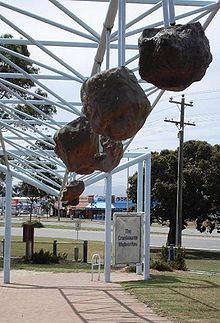Cranbourne (meteorite)

The Cranbourne meteorite is a near Cranbourne ( City of Casey , a suburb of Melbourne ) in the Australian state of Victoria down previous meteorite .
The two largest fragments, weighing 3500 and 1500 kilograms , were counted among the largest in the world at the time they were found. With a total weight of around 8700 kilograms, it is the second largest meteorite find in Australia after the Mundrabilla meteorites .
history
The timing of the fall of the Cranbourne meteorite is unknown, but it is estimated that it fell around 1800.
The first two fragments were discovered around 1853. In 1854 a horseshoe made from meteorite iron (the Cranbourne # 1) was shown at an exhibition in Melbourne . In 1860 it was found that the pieces found so far were a meteorite, which made them the subject of lively scientific interest.
All the pieces found are iron meteorites belonging to the octahedrite class . They have the same composition and their sites are on a line that runs from northeast to southwest and is around 22 kilometers long. This indicates that a meteorite broke into several pieces after entering the earth's atmosphere and fell.
The meteorite pieces Cranbourne # 1 and Cranbourne # 2 passed into the possession of the Natural History Museum in London in 1862 . The loss of these significant objects to Australia sparked outrage, so the Natural History Museum donated the Cranbourne # 2 to the National Museum of Victoria .
Over the years, more fragments have been found - to date there are a total of 13 meteorite pieces. All fragments were found by chance during the construction of railways, roads or during field work - a systematic search has not yet been carried out.
List of the 13 fragments of the Cranbourne meteorite
| Surname | Another name | Found year | Mass kg | Whereabouts; |
|---|---|---|---|---|
| Cranbourne # 1 | 1853 | 3550 | Natural History Museum in London | |
| Cranbourne # 2 | - | 1853 | 1525 | Melbourne Museum |
| Cranbourne # 3 | 1857 | 6.8 | Whereabouts unknown | |
| Cranbourne # 4 | - | 1923 | 1270 | Melbourne Museum |
| Cranbourne # 5 | - | 1923 | 356 | Collection of the Ministry of Primary Industry in Melbourne |
| Cranbourne # 6 | "Packenham" | 1928 | 40.5 | Department of Mineralogy and Petrology of the Melbourne Museum |
| Cranbourne # 7 | - | 1923 | 153 | Collection of the Department of Geology of the Natural Science Institute of Melbourne University |
| Cranbourne # 8 | - | 1923 | 23.6 | Collection of the Ministry of Primary Industry in Melbourne |
| Cranbourne # 9 | "Beaconsfield" | 1876 | 74.9 | was divided and scattered |
| Cranbourne # 10 | "Langwarrin" | 1886 | 914 | Melbourne Museum |
| Cranbourne # 11 | "Pearcedale" | 1903 | 762 | National Museum of Natural History , Washington, DC |
| Cranbourne # 12 | - | 1927 / rediscovered in 1982 | 23 | On permanent loan from the Melbourne Museum to the City of Casey |
Smaller, separated pieces of the meteorites were distributed to other museums.
Others
Replicas of the Cranbourne meteorites are on display in a park in Cranbourne .
Web links
- Entry in the database of the Meteoritical Bulletin
- Publication "The Cranbourne Meteorites" of the City of Casey - Detailed information on the history of the Cranbourne Meteorites
- Information concerning the locations of replicas (English)
- Natural History Museum in London : picture of Cranbourne # 1 (3.5 t )
- Melbourne Museum : Picture of Cranbourne # 2 (1.5t )
Coordinates: 38 ° 5 ′ 50.6 ″ S , 145 ° 16 ′ 57 ″ E
